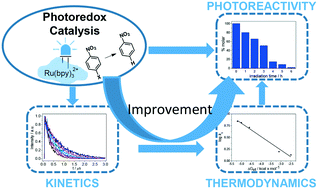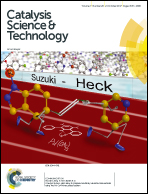A comprehensive mechanistic study on the visible-light photocatalytic reductive dehalogenation of haloaromatics mediated by Ru(bpy)3Cl2
Abstract
Visible light photoredox catalysis is emerging as a versatile technique for a great variety of chemical transformations. Specifically, Ru(bpy)32+ has been widely used as a transition metal-based photocatalyst; however, little if any attention has been paid to the thermodynamic analysis of the photoredox processes that occur in the photocatalytic cycle of the studied reactions or, even more interestingly, to the examination of the kinetic feasibility of the involved processes. In addition, only a few studies on the progress of the reaction have been performed. Organic halides constitute a major concern for environmental remediation since they are reluctant towards aerobic oxidation. Therefore, p-halonitrobenzene (X-NB) derivatives have been selected in the present work as the model compounds to obtain a deeper understanding of their photocatalytic reduction using visible light and Ru(bpy)32+. Thermodynamic estimations were made on the basis of the experimentally determined energy of the LUMO of Ru(bpy)32+, which was determined to be 54.5 kcal mol−1 from the cross-point of the normalized emission and excitation spectra, and redox potentials of X-NB and several sacrificial amines. As anticipated from chemical intuition, the feasibility of the global photoredox process increased upon going down in the group of halogens regardless of the participation of the oxidative or reductive quenching cycles. To unequivocally demonstrate the direct participation of the excited state of Ru(bpy)32+ in the photoreduction, steady-state and time-resolved experiments were carried out upon increasing X-NB or amine concentration; this allowed determining the quenching rate constants for the electron transfer processes, which were found to be in the range of 108 M−1 s−1 for the X-NB and 106 M−1 s−1 for the amines. Therefore, the main role of the oxidative quenching cycle has been demonstrated under the experimental conditions employed. A good correlation was found between the thermodynamic and kinetic parameters, in agreement with the expectations from Marcus theory. Upon optimization of the reaction conditions, reductive dehalogenation was found to occur leading to the parent nitrobenzene.



 Please wait while we load your content...
Please wait while we load your content...